This month-long series of blog posts will explain author websites and offer tips and writing strategies for an effective author website. It alternates between a day of technical information and a day of writing content. By the end of the month, you should have a basic author website up and functioning. The Table of Contents lists the topics, but individual posts will not go live until the date listed. The Author Website Resource Page offers links to tools, services, software and more.
WHEN to Start your Online Presence? NOW! Why?
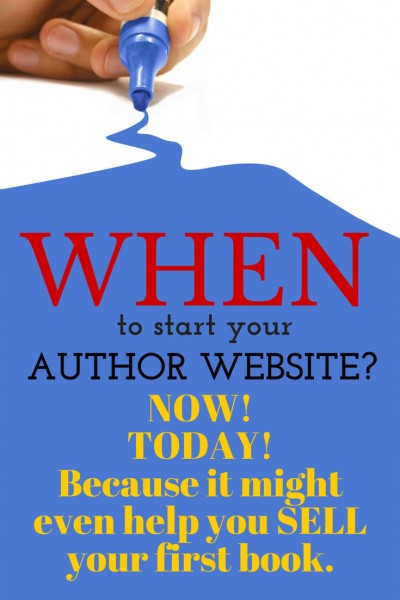
It might help you sell a book!
Here are the stories of how Ruth McNally Barshaw and Greg Pincus turned an online presence into a contract.

Ruth McNally Barshaw: Author/Illustrator
Ruth’s road to publication took an upturn when she attended the 2005 SCBWI Winter Conference. Tell us about what happened:
Upon returning home from the 2005 SCBWI Winter Conference (which Tomie dePaola had told me I HAD to go to) and feeling like a failure (because no publisher showed an interest in me), I uploaded the 180 pages of sketches onto my website, http://ruthexpress.com/
(Note from Darcy: The site has undergone a major remake and she haven’t reposted all of her sketchbooks. Notice that the purpose of a website may change as your career develops and that’s great!)
I sent a link to the Children’s Writers list on Yahoo — the big one Jon Bard started, Peter Davis helped run, and Jan Fields moderated till a few years ago when she started working for ICL. It went viral — I got a thousand emails about the sketches.
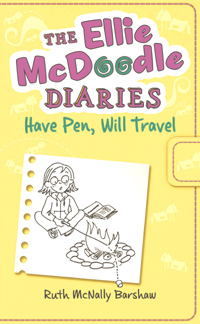 Some of the emails (especially from Mary Siddals, Roxyanne Young, and Kelly Milner Halls) pushed me to do a kids’ book in that sketchbook style, instead of the picturebooks I’d been doing. It all unfolded online — I told the CW list I was working on something in my sketchbook style; it eventually became the first Ellie McDoodle book.
Some of the emails (especially from Mary Siddals, Roxyanne Young, and Kelly Milner Halls) pushed me to do a kids’ book in that sketchbook style, instead of the picturebooks I’d been doing. It all unfolded online — I told the CW list I was working on something in my sketchbook style; it eventually became the first Ellie McDoodle book.
Susan Vaught (author of Trigger, My Big Fat Manifesto and other YA novels) saw the discussion on the CW list, checked out my sketchbook on my website and pointed her agent, Erin Murphy, to it. Erin wrote to me — I had no idea who she was (nor Susan!). I wrote to my most connected writer friends to see if they’d heard of Erin — they were all excited.
Erin and I signed to work together, she sent it out right away, and it sold pretty fast. (I got to meet Susan 2 years later at Erin’s first client retreat in 2007. She’s brilliant and gracious and I’m forever grateful to her!) I didn’t know about Diary of a Wimpy Kid back then — I think it was an online comic. His first book came out one month before the first Ellie. There are now five Ellie books, and the sixth comes out in fall, 2014. Ruth is working on a few picturebook series at the moment.
Join me in August, 2014 the Boston area for a one-day workshop, BUILD YOUR AUTHOR WEBSITE. I’ll also be teaching a Novel Revision Retreat and a one-day Picture Book Workshop. Get the details here.
Greg Pincus – Poet
On April 1, 2006, Greg Pincus wrote a blog post about a new type of poetry form, “the fib.” Greg described it as a “six line, 20 syllable poem with a syllable count by line of 1/1/2/3/5/8 – the classic Fibonacci sequence.” The blog post went viral. It was picked up by Slashdot on the 7th of the month and was in the New York Times on the 14th.
That was exciting enough, but it wasn’t the end. Instead, publishers started bidding on a book contract for Pincus, something that would include the Fib poetry form. Greg tells the whole story here, but the bottom line was a two-book contract with Arthur Levine Books/Scholastic.
Greg said, “Yes, of course, it was surprising…though it was also the hoped for result. I mean, I did have intent when I launched The Fib.”
An author website can help you GET published. And when you DO sell, you’ll be well on your way to developing an audience!
Building a successful blog can take 3 years. Surprised?
Think about it—the amount of content on a beginning blog is small, so there’s nothing for a reader to DO when they come to your site. Usually, you’ll need a significant amount of info to bring readers to your site on a regular basis. That takes time. Posting 5x/week for a year gives you 260 posts; after two years you would have 520 posts; and, after posting 5x/week for 3 years you’ll log 780 posts. With a blog that deep you have a chance of hooking a reader and keeping them on your site reading for a long time. Over time, you pick up readers who like your way of discussing things and you grow an audience. But it doesn’t happen over night.
Do you want to sell a single book or do you want a career? If you want a career, start now to network, to find readers, to build an audience. Think about it this way: you are a small business. In the US, it usually takes a small business three to five years to turn a profit. Three years to build a good blog audience is about normal!
This is a screenshot of this blog’s statistics for traffic from 2007-2012. As you see, it took a long time to build to an audience of about half a million per year.
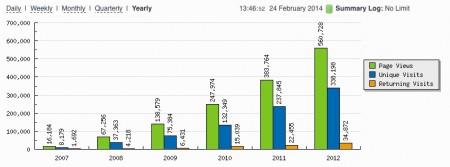
You Must Start Now!
Jane Friedman said this about the importance of a direct marketing strategy: “Authors are in a key position to reach readers directly, but most are ignorant of its importance, and of how to turn reader contact today into revenue tomorrow.”
Authors must begin to develop an audience long before they need an audience!
Here’s Jane talking about the slow build to growing an audience.
If you can’t see this video, click here.
How has your website helped your career? Leave a comment with your experience Pre-Publication.
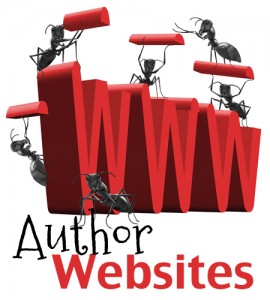
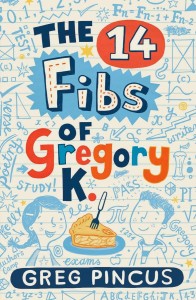
Thanks for sharing more!
Building a website is a construction zone.
My website has helped my career in many ways – When people ask me if I have a website, I can answer yes. Also, I have a place to house some of my favorite clips. Editors can stop by my website and get a quick sense of what I offer.
I also link my Twitter site and LinkedIn site to my website.
And for my website to be successful, I need to remember it’s not static.
I like what Jane Friedman said. “Don’t be afraid to experiment.”
Heather:
Jane Friedman always has wise words. I think a website is always a moving target, changing as your career changes.
Darcy
This was particularly encouraging, and although I have very few followers I’m more confident now that I’m on the right track.
I had a very small lightning strike with the 14:14 Picture Book Review Challenge I participated in (starting with a review of one of Darcy’s books!) and that was exciting. I know now to keep on keeping on, but to rely on those little bubbles too, because they may grow bigger over time.
Damon:
Sometimes it seems like a website is a slow build, but it’s worth it in the end.
Darcy
Great site for writers. Thanks for sharing.
Building a website and creating a thriving community of followers may appear daunting, but well worth the effort. It’s the little gains -when a follower reblogs your piece, when something you’ve written starts a conversation – that sets the ball rolling. I am an Indie writer looking at a possible August launch for my first book. I recently asked Katie Davis (Brain Burps About Books) about the proper timing for my book website release and she said, “last year.” So true. Community building takes time.
Katie is right: Last year! But there’s still lots you can do in three or four months. You just have to work harder.
Darcy
I’ve just found this blog and it looks great.
Starting a blog is fine by me but what content as an author do you provide?
I am not a “hot to write…..” kind of guy because I lack experience and technical know how.
So what does an author blog look like?
Love to hear your thoughts